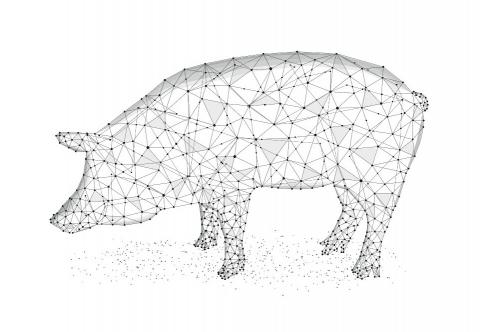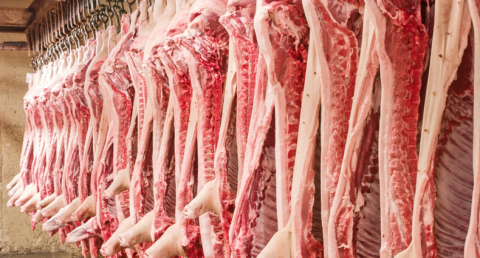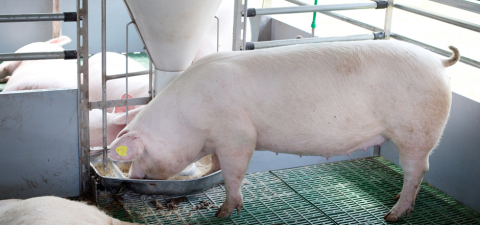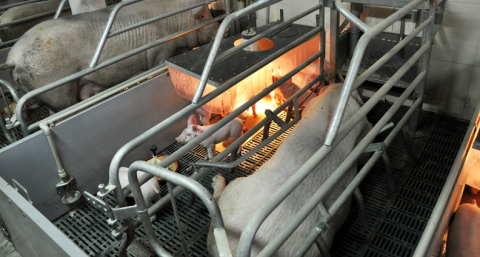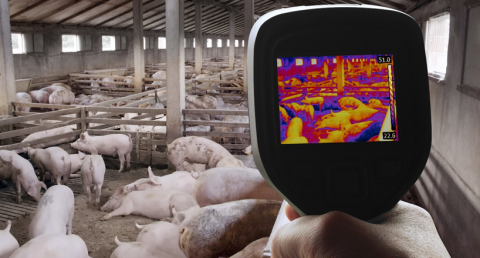30 September 2020
Dr David Cutress: IBERS, Aberystwyth University.
- Pig meat has been one of the top sources of meat globally for over 40 years
- Precision technologies aim to improve efficiency, productivity and animal welfare of pigs with most being utilised in larger-scale production systems
- The pig sector appears to have an innovative approach to utilising precision technologies to target the ever-important aspect of biosecurity
Background
According to FAO figures (UN Food and Agricultural Organisation) pig meat has been the most popular source of meat since the late ’70s, having only recently (2016 onwards) been narrowly overtaken by poultry meat. Compared to the rapid growth observed in the poultry sector, pig production has remained strong supplying consistently between 35 – 40% of the global meat production market. With the global population predicted to grow by 2050 to a level which would require between 50 and 60% more food, it is clear to see that the pig industry will play an important role in providing this output. The UK pig meat sector has seen fairly stable consumption levels along with a slight upwards trend in self-sufficiency in the last 4 - 5 years, suggesting improved uptake of pig farming or improved efficiency on farms. With a growing concern for sustainability being a primary target across all farming sectors achieving a consistent increase in production levels is a must and, increasing efficiencies will be key to this. Producers must strive to achieve higher production whilst balancing a need to maintain or reduce the agricultural land used (as freed land could be utilised for further food production or greenhouse gas (GHG) emission mitigation strategies) and maintaining high standards of individual welfare for an ever-increasing number of animals. Maintaining these high animal welfare standards becomes an issue in ever more intensive environments due to the increase in animals per stock person ratios and is a noted difficulty in Europe where availability of workers is limited and expensive (€ 25 per hour), resulting in pressure to improve labour performance and automation. Precision livestock technologies offer the ability to have constant monitoring of large numbers of animals labour free (at an individual level in many cases) as well as data-driven real-time processing to provide farms with useful information and alerts to improve management practices. Whilst the pig industry has seen long-term stability and sustained growth, global figures were set to fall for the end of 2019 due to the African swine flu (ASF) presence in China (which produces around 45% of all pig meat globally) and other east Asian countries. Disease control strategies and improving general pig health is another area where precision technologies could play an important role in this sector. This article aims to give an overview of areas where technology is being developed or already commercially available in the pig meat sector and note the benefits these aim to provide.
Precision technology developments
Identification
One of the key factors towards managing increasing numbers of animals whilst maintaining the capacity to monitor individuals from within a group is being able to accurately identify specific animals. This is important as specific data needs to be paired to individual animals to best manage that animal, whether that data is weight, feed intake, growth rate or health status. Radio-frequency identification (RFID) technologies are increasingly common across agriculture and are usually incorporated into animal ear tags. Various types of RFID have been trialled in pigs from low to ultra-high frequency systems. Low-frequency systems rely on proximity to readers but have been incorporated heavily into automatic weight scale systems and feeder systems. Ultra-high frequency systems have also been assessed experimentally to try and track multiple pigs at the same time but the current technology is highly sensitive to interference from pig ear tissues. The main disadvantages of RFID based identification are the possibility of physical detachment from the animal and single individual detections, these issues could be overcome through the use of image identification tools.
Image analysis
Imaging techniques for identification and tracking are completely non-invasive requiring no contact with animals freeing them to behave more naturally (whilst equally reducing many biosecurity risks). A wealth of work has been put into identifying individual pigs via both traditional and 3D camera systems. Due to the industry pressure to produce uniform products it can be difficult for image analysis to tell pigs apart, or even determine which end is the head and which is the tail. As such many of these systems still rely on printed, sprayed or tagged elements being applied to the backs of pigs which a computer can identify more easily. Recently, research has moved on to assessing subtle differences in pig faces as a method of identification with cameras mounted at pig height at water drinkers or feeders. Features such as wrinkles above the snout, head markings and eye regions show the best difference between animals with accurate IDs in some studies up to 96.7%. This technology has also been suggested to have potential use in future to detect prolapse syndromes in sows (due to the visibility of the protrusions) which is noted to be an increasing problem in the industry increasing euthanasia cases.
As well as identification, image analysis has been used to assess behaviours including; locomotion analysis (which works towards improving welfare and is used to detect oestrus, time of farrowing and disease traits such as ASF infections), tail biting detection (improved welfare), pregnancy-related behaviour analysis (improved health), respiration rate detection (as a proxy for heat stress), damaging mounting behaviour detections (improves health particularly in male intact pigs) and response to environmental conditions (optimise the environment for growth and welfare). Monitoring behaviours can give farmers an increased level of control over their animals with minimal additional labour. There has been a fairly slow progression into commercial availability for many of these more complex systems and this may be due to a lack of collaboration between researchers. Many systems appear to begin production from scratch rather than utilising aspects of research which have already been developed and refined.
Ultimately the meat content of pig carcasses are the main output of the sector and as such accurately measuring this can be important pre-slaughter to provide feedback, which could be used to improve quality and post-slaughter as a retrospective tool. Magnetic resonance imaging (MRI) can be a powerful tool to assess pig meat traits in breeding pigs to assist in selective breeding programmes. Computed tomography (CT) is another tool that has the ability to look at lean meat content and other carcass quality factors in live pigs towards management and selective breeding to improve production gains. Ultrasound analysis has been suggested to be possible to be integrated into housing units as part of an automated growth analysis system. On exit from feeding areas, pigs could pass through an ultrasound system which could assess carcass quality via backfat thickness. It was shown that such systems could assist in improving feed intake towards optimal body composition and carcass quality at slaughter.
Remote non-invasive weighing of multiple animals continuously is another potential of commercial systems (such as eYeScan and eYeGrow from Fancom) using 2D and 3D cameras to track average weight gain of a pen of fattener pigs. Other systems are looking to use 3D cameras to make previous labour-intensive measures (such as heart girth measurements) automated. Improving automated 24/7 weight monitoring allows feed adjustment or environment parameter adjustments to be targeted to optimise production gains.
Water intake
Provision of water supply is key for animal welfare and continued growth and health across all livestock. Smart integrated water meters are a commonly used precision technology particularly in indoor raising systems such as with pigs and poultry. Meters can provide information on water use across entire sheds, specific compartments or individual pens to help manage pig hydration levels. Individual pig intake levels have been determined by incorporating nipple drinkers with RFID identification devices to observe changes in normal drinking profiles that could be linked with disease, stress or other health and welfare concerns.
Feeding and feed intake
Precision feeding uses technologies to ensure correct amounts of feed with suitable nutritional values are supplied promptly to groups or individual animals, leading to increased efficiency, sustainability, health, welfare and optimal production levels. It is fairly commonplace for large pig production units to have automatic feeders with integrated RFID tag readers and use other information (such as growth profiles) on the individual pigs to provide a specific feed ration. Vitally, feeding behaviours have been demonstrated to have high potential in identifying which pregnant sows have a higher risk of losing offspring by observing if total time spent at feeders is less than normal. Furthermore, feed intake of lactating sows has a huge impact on continued successful oestrus and the weight and performance of litters following birth, with this able to be accurately monitored with automatic feeding systems. By including automatic weight scales at these feeders, farms can optimise growing-finishing pigs further via new analysis ratios which compare the direct amount of amino acid content to supply each pig to increase protein deposition and daily gain.
Oestrus and fertility
Detecting oestrus and ovulation can massively improve successful insemination, increasing production values and decreasing costs associated with labour and sperm where multiple inseminations are performed. Generally, 24 hours before ovulation is the optimum time to perform insemination in pigs, however, to ensure this window is covered multiple inseminations are performed at 24-hour intervals surrounding ovulation periods based on visual inspection. Whilst previous automated systems such as Dategate have reduced labour and improved success of insemination these could be improved further by including specific oestrus detection technologies. Commercial oestrus detection technologies such as PigWatch are based on behavioural changes observed via movement sensors for individual animals or cameras to observe behaviour changes of multiple pigs at a time. More experimental approaches also include temperature changes associated with the onset of oestrus which can be detected by vaginal devices and infra-red thermography.
Environmental systems
The indoor nature of large-scale pig production makes environmental aspects including temperature, lighting, gases, humidity and ventilation far easier to accurately control. Incorrect environmental conditions can lead to limits on production efficiency, performance and welfare along with increases in disease, mortality and heat stress. Many commercial systems are available for total environment monitoring including those offered by Fancom which allow automatic corrections to be performed to consistently improve internal conditions. Such systems are linked to heating and ventilation controls and can maintain static conditions but could also be combined with research outputs to help better predict future disease occurrence (and provide warnings of such). Disease occurrence has been linked to temperature changes in the facility or humidity and CO2 changes such as is under investigation by the CIEL project in Newcastle University.
Biosecurity
Biosecurity, was noted in a recent Farming Connect communication, as a key pig production consideration and its importance is evident when considering the cases of the 2009 swine flu and recent ASF outbreaks. The pig sector appears to be the first livestock sector looking into the specific use of precision technologies to better identify and manage biosecurity risk areas within their systems. Commercial technologies (for example PigCHAMP - Biorisk®) look to track a stock person’s movement throughout various farm areas via communication with receiver devices in pre-determined zones of interest (e.g. barn entrances and equipment rooms) which pick up signals from Bluetooth transmitters that staff wear. If infection spread occurs this system allows accurate tracing and management plans can be changed to prevent future infections or staff involved can be trained further to reduce future risk of re-occurrence. Trials for controlling porcine reproductive and respiratory syndrome (PRRS) found unsafe movements of individuals between infection areas reduced by up to 27% with PRRS prevalence in farrowing units showing decreases of 50% following implementation. The functionality and results of such systems suggest this strategy could be something well adapted to other livestock sectors in the future.
Robotics are present in the form of automated cleaning systems. To date these systems are simply autonomous and fixed in routines with no ability to adapt and assess the cleaning performed, often leading to excess work for farm staff if cleaning is inefficiently performed. The integration of image analysis and machine learning into such systems could improve hygiene and biosecurity whilst also reducing labour requirements further.
Welfare and health
Technologies such as accelerometers, pressure sensors, temperature detection, audio and heart rate detection have potential roles in improving health and welfare.
Pig production was a pioneer in detection of disease and stress through audio sensors, with much of the current work in other livestock sectors being based on systems such as Soundtalks and Fancoms Pig Cough monitor. Systems detect pig cough quality and frequency and other audio cues linked to respiratory and wasting diseases as well as stress.
Accelerometers (or movement sensors) have mostly been used for detecting the onset of farrowing, similar to commercial systems in other livestock species such as MooCall for cattle calving alerts. Alerts could ensure minimal time is spent in the farrowing crate which can improve sow welfare, with the suggestion that systems can alert farmers 2 - 3 hours before the event occurs.
Pressure sensors, similar to those used with cattle, in underfoot plates can detect gait changes in pigs and detect lameness incidences earlier.
Human health and fitness technologies towards monitoring heart rate have recently been assessed for functionality in pigs. Stress affects heart rates and as such, live monitoring could help producers implement managerial changes to reduce stress rates. Initial testing suggests such technology is highly accurate, but there are issues in their use on animals in making the technology robust enough to withstand physical damage and stop accidental removal.
The most developed health and welfare-based sensors appears to be temperature analysis. Temperature is vital in assessing animal health with fluctuations being linked to stressors, disease/infection, illness and changes in oestrus of sows. Accurate detection of core body temperatures requires a high level of labour in the form of rectal temperature probing of each animal, as such many technologies have been assessed to automate this and, in most cases, make it a less invasive process. The exception to reduced invasiveness involves the testing of implanted temperature capsule systems, whilst these demonstrated accurate temperature analysis when compared to rectal results, the need for anaesthesia of animals and surgical implantation make these an unviable option for industrial use. Commercial temperature and humidity logger systems have also been tested on pig ears such as iButton loggers. Whilst these are not considered precise (as data has to be collected retrospectively) they have helped prove the concept that monitoring assists in breeding selection as temperature changes were demonstrated to be linked to feed efficiency in finisher pigs. Most temperature sensing developments involve infra-red thermography tools as these are entirely non-invasive and if optimised can monitor temperature conditions of multiple animals at once. The best surface areas to assess for body temperatures using these tools are around the eyes and ears, with previous work in piglets demonstrating a role in assessing vitality and intake of initial colostrum success. Other systems have found roles in general piglet health monitoring, detecting cold stress, detecting thirst,, monitoring temperature relating to environmental changes and in the monitoring of aggressive behaviour.
Other meat sectors suggest in future there could be increasing roles to play for biosensor incorporation to further improve disease detection and monitoring of health and welfare. Recent surveys of key members of the pig sector in the Netherlands suggest that there is specific potential for precise real-time hormone measurement for even greater improved ovulation tracking and that biometric identification of individual pigs is a key future consideration.
Summary
A wealth of technologies are available or in development that can assist in improving the welfare, health and productivity of the pig sector. Many of these are becoming commonly utilised, particularly in larger-scale production systems due to the animal level benefits they provide as well as the labour-saving aspects associated with automation. As with most sectors when considering precision technologies there exists issues surrounding the access and usability of the data being collected, with problems surrounding integrating systems and data from different providers and a lack of freedom in software’s ability to generate novel reports, this can force producers into subscriptions to entirely new software unnecessarily. Of particular note, the pig sector appears to be the first area to be utilising precision technologies commercially towards improving biosecurity on farms. Development of such systems to other sectors could be a key route towards improving an area that is consistently regarded as lacking within agricultural management.


